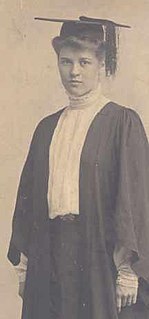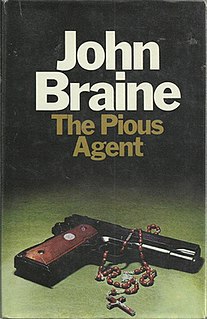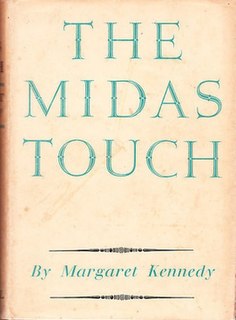
Naomi Mary Margaret Mitchison, Baroness Mitchison was a Scottish novelist and poet. Described a doyenne of Scottish literature, she wrote over 90 books of historical and science fiction, travel writing and autobiography. Her husband Dick Mitchison's life peerage in 1964 entitled her to call herself Lady Mitchison, but she never did. Her 1931 work, The Corn King and the Spring Queen, is seen by some as the prime 20th-century historical novel.
Nancy Barbara Bond is an American author of children's literature. In 1977 her first book, A String in the Harp, was fantasy novel with an element of folklore, set in West Wales. It received a Newbery honor and the Welsh Tir na n-Og Award, and remains in print.

Margaret Ayer Barnes was an American playwright, novelist, and short-story writer. She was awarded the Pulitzer Prize.
Molly Winifred Holden was a British poet.

The Ordeal of Richard Feverel: A History of Father and Son (1859) is the earliest full-length novel by George Meredith; its subject is the inability of systems of education to control human passions. It is one of a select group of standard texts that have been included in all four of Everyman's Library (1935), the New American Library of World Literature (1961), Oxford World's Classics (1984), and Penguin Classics (1998). With its rigorous psychological analysis and criticism of contemporary attitudes to sexuality, it has been seen by some critics as the first modern novel in English literature.

Annie Shepherd Swan, CBE was a Scottish journalist and fiction writer. She wrote mainly in her maiden name, but also as David Lyall and later Mrs Burnett Smith. A writer of romantic fiction for women, she had over 200 novels, serials, stories and other fiction published between 1878 and her death. She has been called "one of the most commercially successful popular novelists of the later nineteenth and early twentieth centuries". Swan was politically active in the First World War, and as a suffragist, a Liberal activist and founder-member and vice-president of the Scottish National Party.
Margaret Kathleen Maddocks was a British writer of 17 gothic and romance novels. Before retiring she wrote her autobiography: An Unlessoned Girl in 1977. She is the only novelist to win four Romantic Novel of the Year Award by the Romantic Novelists' Association.
Frances Murray is the pseudonym used by Rosemary Frances Booth, née Sutherland, a Scottish writer of children's and romance novels. In 1976, her novel The Burning Lamp won the Romantic Novel of the Year Award by the Romantic Novelists' Association.
Anne Eyre Worboys was a New Zealand-British writer of 40 romance and suspense novels. She also signed her novels as Annette Eyre and Anne Worboys, and under the pseudonym of Vicky Maxwell. In 1977, her novel Every Man A King won the Romantic Novel of the Year Award by the Romantic Novelists' Association.

An Imaginative Man is an 1895 novel by the British writer Robert Hichens. A tale about a young honeymooning man in Cairo who eventually goes mad after a series of sexual adventures and kills himself at the Great Sphinx, it was a commercial hit and Hichens wrote a number of further books in the orientalist style.

Stay with Me Till Morning is a 1970 novel by the British writer John Braine.

The Pious Agent is a 1975 spy thriller novel by the British writer John Braine.

The House in Dormer Forest is a 1920 romance novel by the British writer Mary Webb. It was part of a wave of regional novels set across Britain, in Webb's case in her native Shropshire. She wrote it while living at her home near Bayston Hill. It was one of several works that inspired the later parody novel Cold Comfort Farm by Stella Gibbons.

Seven for a Secret is a 1922 romance novel by the British writer Mary Webb. She wrote to Thomas Hardy asking if she might dedicate the novel to him, to which he agreed. As with her other novels it takes place in her native Shropshire. The title is taken from the traditional nursery rhyme One for Sorrow.

Gone to Earth is a 1917 romance novel by the British writer Mary Webb. It was her second novel following her debut The Golden Arrow the previous year. It received positive reviews and Rebecca West described it as her book of the year. It is set in Shropshire around Long Mynd and Wenlock Edge. In 1935 it was one of the first batch of Penguin Books published.

Paying Guests is a 1929 comedy novel by the British writer E.F. Benson, best known as the author of the Mapp and Lucia series. The story takes place at Wentworth, a boarding house in the fictional resort town of Bolton Spa. It focuses on the eccentric collection of summer residents, mostly there to try and recover their health, overseen by the domineering former Indian Army Colonel Chase. It has been described as "The coming together of character and situation in Paying Guests creates a comic masterpiece, worthy to stand alongside the Mapp and Lucia books".

Lucy Carmichael is a 1951 romantic drama novel by the British writer Margaret Kennedy. It was her tenth published novel. It was well-received by critics but did not repeat the success of her earlier hits The Constant Nymph and Escape Me Never. It was a Literary Guild choice in America. In 2011 it was reissued by Faber and Faber.

The Midas Touch is a 1938 novel by the British writer Margaret Kennedy. It was her eight novel, she then took a decade-long break before producing her next work The Feast in 1950. It was a Daily Mail Book of the Month.

The Ladies of Lyndon is a 1923 novel by the British writer Margaret Kennedy. Her debut novel, it was rell-received and she followed it the next year with her breakthrough novel The Constant Nymph.

Red Sky at Morning is a 1927 novel by the British writer Margaret Kennedy, her third. Her previous novel The Constant Nymph had been a major critical and commercial success, and it was felt that her new novel failed to recapture this. Sylvia Lynd reviewed it saying "Few novels have so exquisite a forerunner as The Constant Nymph with which to compete. Compared with that, Red Sky at Morning, it must be admitted, is far less moving, less inevitable in the progress of its events, and less well stocked with fascinating characters. Compared with any ordinary novel, however, it is very good indeed - finely wrought, just, sensible, perceptive and witty".















